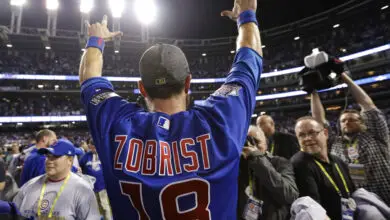
Cubs Currently Projected to Trim Payroll by $40-50 Million for 2021, Second Winter of Big Cuts
Even though it should go without saying because of the use of “currently” in the title, I want to make very clear that I am operating under the assumption that the Cubs will actually make more moves this winter to alter their 2021 payroll. However, it’s entirely possible — likely, even — that those moves will serve to further lower their obligations beyond the titular range.
I don’t know about you, but that makes me angry. There are certainly plenty of people out there who will gladly carry water for team owners as the imaginary stewards of their fandom, but there’s really no excuse for what’s taking place across the league. An argument can be made that the reduction in player payroll is but a temporary reset based solely on the pandemic, but the Cubs also trimmed over 100 employees from baseball and business operations.
And we’re talking sweeping cuts from scouting and development, which will have a fundamental impact on the club for years to come. Not a great step for an organization that doesn’t exactly have a sterling reputation when it comes to player development over the last decade. The shortcomings go back longer, of course, but we’re talking about the legacy of the current regime.
According to FanGraphs’ RosterResource, the Cubs had an estimated competitive balance tax payroll of $217.7 million for 2020. That’s almost $10 million over the $208 million CBT threshold, their second consecutive overage, but it’s approximately $25 million less than their 2019 figure. Actual payroll for 2020 was $199 million before proration, roughly $23 million less than the previous year.
In short, this winter isn’t the first time the Cubs are making significant cuts to the baseball budget.
Speaking of which, their actual cost for player salaries in 2020 was really closer to $73.6 million based on only having to pay 37% due to the shortened season. That figure is awfully close to the Cubs’ purported losses of $120-140 million due to the lack of fans, though we will never know exactly how they arrived at those numbers and whether the payroll surplus offset them or was kept in a separate column of the ledger.
As things currently sit, the Cubs are carrying an estimated $156.5 million in actual payroll and a $164 million CBT figure into the 2021 season. Those numbers are anywhere from $43-54 less than in 2020 and $65-79 million less than in 2019, which is a little alarming even if it’s not entirely relevant. The important number is the $46 million Jed Hoyer has to work with while remaining under the $210 million CBT threshold that is undoubtedly a hard cap this year. Even assuming a $10 million safety buffer, there’s still $36 million remaining.
But if you believe for a second the Cubs are actually going to spend a significant portion of that, you might want to look back at their two previous free agency periods. In that time, the Cubs agreed to a total of just over $10.6 million in guaranteed deals with five players. Add in Craig Kimbrel, whose deal came midway through the 2019 season, and you’ve got $53.6 million total. Break it down to an annual average and you’re at $22.6 million.
Barring an unforeseen shift in strategy, the Cubs are not going to sign anyone for anywhere close to Kimbrel’s $14 million. Factor in the possibility that they’ll trade away at least one more player from their core group and those payroll figures above could still drop significantly. This winter might be looked at as the reckoning that’s been teased for a while now, but it’s really little more than the next iteration of what will be at least a three-year trend.
Let’s hope it only lasts that long because yet another season with a restricted budget would be even less acceptable than what’s happening now. Again, I’m not just talking about the contracts Hoyer has the money to hand out. Biblical losses or no, a very small portion of the money the Cubs have cut from the player personnel side of the house would have easily offset the salaries of those dozens of former employees forced to seek new work.
I won’t get into the idea that the league reaped a massive windfall from national broadcast contracts over the course of expanded playoffs. Nor will I harp on the $3.7 billion extension with Turner Sports that nets owners a 65% increase in their annual postseason rights fees, a figure that coincides nicely with the 37% salary level mentioned above. If owners had to take on debt in order to finance their operations this past season, wouldn’t it figure that they’d be willing to leverage future increases in earnings to remain competitive in ’21?
My sincere hope is that this is indeed a temporary hiccup in the Cubs’ operations and that they’ll return to the land of big spenders very soon. But that still won’t bring back all the jobs that have been lost in the meantime or replace the trust in ownership that has eroded at a quickening pace in the time since the Cubs hoisted the World Series trophy.
My kingdom for a sign of hope.

